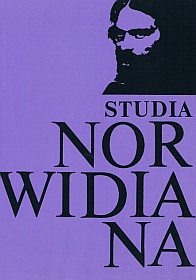The Poetics of the Maxim in Cyprian Norwid's Vade-mecum. Its Identification, Extent and Significance
Abstract
Norwid's Vade-mecum is aphoristic to an extent that determines the semantics and structure of the whole poetic cycle. It also shows that the poet was influenced in many ways by the Christian religion and culture and by the literature and culture of the classical antiquity. In many respects, the aphoristic character of the Vade-mecum stands in opposition to the theory and practice of Romantic poetic language.
The sententia, or maxim, is a very important element in the aesthetics of Norwid's poetry. In the Vade-mecum it plays a semantic, structural and genological role. In poetry at large, the maxim serves as a means of a generalising mode of expression, laconic and at the same time both poetic and philosophical. As a genre the maxim is a context-dependent form. It contributes to a poem's genological richness and polymorphous quality. Norwid's choice of it as a way of expression shows his preference for addressee-oriented genres.
Structurally, the maxim is firmly embedded in the matrix poetic text, while syntactically it functions as an element of a multi-layered structure. Only a few of Norwid's maxims represent independent, simple syntactic units.
The essence of Norwid's maxims in the Vade-mecum is that they enable him to make his points extremely laconically, in a way that is brief and yet precise; his formulations read like timeless laws and truths. The internal structure of his sententiae, which can be extremely varied, is governed by the rule of maximum content with minimal verbal weight. They are unusually precise and laconic formulations and they often exploit the ambiguity of words.
What instigates the poet's use of a maxim is a specific situation, a small detail, an individual gesture. The maxim can generalise the particular: it can endow the detail with universal qualities. When he tries to explain a thing, to apprehend its traits, Norwid makes use of pseudo-definitions, which are often based on contrast, antithesis or paradox.
A poem may begin with a sententia, which functions as its thesis. Such a start makes for the structural cohesion of the text. In most cases, however, the maxim is the compositional coda of the poem. These cases show Norwid as the master of the coda. Such distribution of the maxims stresses Norwid's strategy of using the initial and concluding parts of a poem as specially marked places; maxims frequently form a compositional brace for the text as a whole.
Copyright (c) 2003 Studia Norwidiana

This work is licensed under a Creative Commons Attribution-NonCommercial-NoDerivatives 4.0 International License.





